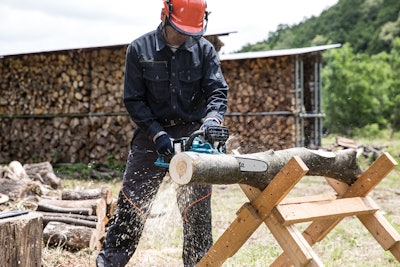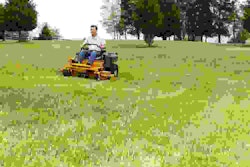 Hearing protection like earplugs or earmuffs should not be forgotten when operating loud equipment.
Hearing protection like earplugs or earmuffs should not be forgotten when operating loud equipment.Hearing loss can be a serious issue for Green Industry workers. According to the Occupational Safety and Health Administration (OSHA), 22 million workers are exposed to potentially damaging noise at work each year. Hearing loss is the 3rd most common chronic physical condition among adults.
It is estimated that $242 million is spent annually on workers’ compensation for hearing loss disability.
Landscapers are particularly vulnerable to hearing loss due to the numerous types of loud equipment they must use to get the job done. While hearing loss is permanent, it is 100 percent preventable.
So how loud is too loud? Long or repeated exposure to sounds at or above 85 decibels (dBA) can result in hearing loss and the louder the sound, the shorter amount of time it takes for hair cells in the inner ear to be damaged.
Employees who are affected by hearing loss can result in impacts on both the worker and the business.
Personally, workers can become unqualified for jobs that require good hearing, they can struggle to friends and family and they can have home safety problems if they can no longer hear alarms or people calling out for help.
On the jobsite, the risk of injuries increases as effective communication is diminished and workers are less likely to hear warning signals. Employees can also struggle to understand orders, clearly leading to mistakes and miscommunications.
What is even worse is if hearing loss is left untreated. Some may not know or not want to acknowledge the problem, but choosing to “get by” without a hearing aid can result in stress, depression, avoidance of social situations, reduced alertness and impaired memory.
Signs of noise being at a dangerous level are if you have to shout over the sound to be heard, the noise is painful to your ears, the noise makes your ears ring, you have decreased or muffled hearing several hours after exposure.
For every 3 dBA above 85, the permissible amount of exposure time is cut in half. Below is a list of sample dBA levels and permissible time amount.
- 85 dBA – 8-hour exposure limit
- 88 dBA – 4-hour exposure limit
- 91 dBA – 2-hour exposure limit
- 94 dBA – 1-hour exposure limit
- 97 dBA – 30-minute exposure limit
- 100 dBA – 15-minute exposure limit
- 103 dBA – 7 ½-minute exposure limit
- 106 dBA – 3 ¾-minute exposure limit
An example of how easily hearing damage can occur is when a landscaper runs a chainsaw without hearing protection, which tends to have a dBA of 110, for just two minutes can be dangerous to the human ear.
Some of the methods of control for preventing hearing loss are to remove the hazard, replace the equipment with quieter models, isolate crews from the loud equipment, change the amount of time workers are exposed to the noise and wearing personal protective equipment.
These vary in effectiveness and feasibility depending on your operations, but making an effort to reduce and mitigate noise levels will help your workers as well as reduce complaints from the community.
Company owners can visit HearingAtWork.org to get free earplugs, download noise-level apps and get additional information.
Another tool to help provide information on hearing loss is OSHA’s pocket guide, which goes into determining tools’ noise levels and how to prevent hearing loss.
Tips for good hearing health:
- Keep available personal protective equipment including earplugs, earmuffs or canal caps with appropriate noise-reduction ratings for the job.
- Get an annual hearing test.
- Make sure your protective equipment fits and maintain it properly.
- Tell your supervisor if you experience humming or buzzing in your ears.
- Don’t muffle sounds so much that you can’t hear safety instructions.











